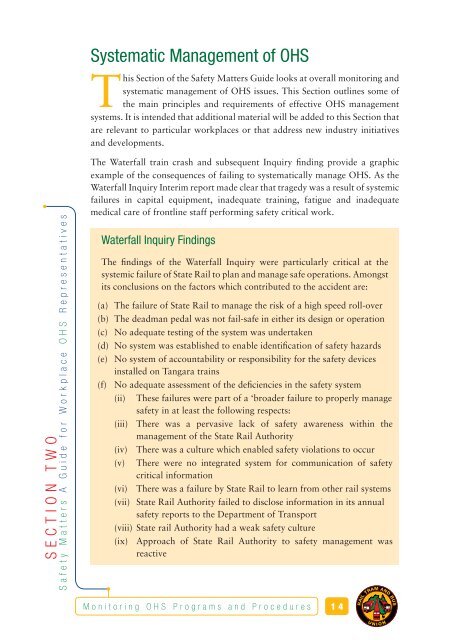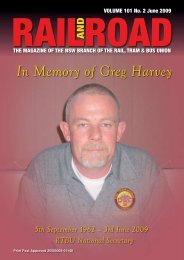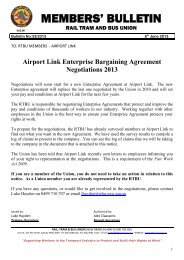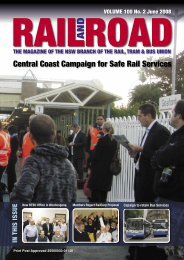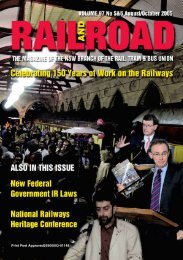Safety Matters - Rail, Tram and Bus Union of NSW
Safety Matters - Rail, Tram and Bus Union of NSW
Safety Matters - Rail, Tram and Bus Union of NSW
You also want an ePaper? Increase the reach of your titles
YUMPU automatically turns print PDFs into web optimized ePapers that Google loves.
Systematic Management <strong>of</strong> OHS<br />
This Section <strong>of</strong> the <strong>Safety</strong> <strong>Matters</strong> Guide looks at overall monitoring <strong>and</strong><br />
systematic management <strong>of</strong> OHS issues. This Section outlines some <strong>of</strong><br />
the main principles <strong>and</strong> requirements <strong>of</strong> effective OHS management<br />
systems. It is intended that additional material will be added to this Section that<br />
are relevant to particular workplaces or that address new industry initiatives<br />
<strong>and</strong> developments.<br />
SECTION TWO<br />
<strong>Safety</strong> <strong>Matters</strong> A Guide for Workplace OHS Representatives<br />
The Waterfall train crash <strong>and</strong> subsequent Inquiry finding provide a graphic<br />
example <strong>of</strong> the consequences <strong>of</strong> failing to systematically manage OHS. As the<br />
Waterfall Inquiry Interim report made clear that tragedy was a result <strong>of</strong> systemic<br />
failures in capital equipment, inadequate training, fatigue <strong>and</strong> inadequate<br />
medical care <strong>of</strong> frontline staff performing safety critical work.<br />
Waterfall Inquiry Findings<br />
The findings <strong>of</strong> the Waterfall Inquiry were particularly critical at the<br />
systemic failure <strong>of</strong> State <strong>Rail</strong> to plan <strong>and</strong> manage safe operations. Amongst<br />
its conclusions on the factors which contributed to the accident are:<br />
(a) The failure <strong>of</strong> State <strong>Rail</strong> to manage the risk <strong>of</strong> a high speed roll-over<br />
(b) The deadman pedal was not fail-safe in either its design or operation<br />
(c) No adequate testing <strong>of</strong> the system was undertaken<br />
(d) No system was established to enable identification <strong>of</strong> safety hazards<br />
(e) No system <strong>of</strong> accountability or responsibility for the safety devices<br />
installed on Tangara trains<br />
(f) No adequate assessment <strong>of</strong> the deficiencies in the safety system<br />
(ii) These failures were part <strong>of</strong> a ‘broader failure to properly manage<br />
safety in at least the following respects:<br />
(iii) There was a pervasive lack <strong>of</strong> safety awareness within the<br />
management <strong>of</strong> the State <strong>Rail</strong> Authority<br />
(iv) There was a culture which enabled safety violations to occur<br />
(v) There were no integrated system for communication <strong>of</strong> safety<br />
critical information<br />
(vi) There was a failure by State <strong>Rail</strong> to learn from other rail systems<br />
(vii) State <strong>Rail</strong> Authority failed to disclose information in its annual<br />
safety reports to the Department <strong>of</strong> Transport<br />
(viii) State rail Authority had a weak safety culture<br />
(ix) Approach <strong>of</strong> State <strong>Rail</strong> Authority to safety management was<br />
reactive<br />
RAIL<br />
Monitoring OHS Programs <strong>and</strong> Procedures<br />
14<br />
TRAM AND BUS<br />
U N<br />
I O N


